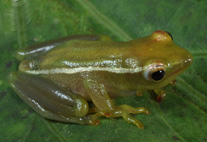Abstract
The oribatid mite genus Protoribates Berlese (Haplozetidae) is reviewed for North America and the genus diagnosis is revised to account for the North American species, Protoribates robustior (Jacot, 1937) is redescribed and newly reported from western North America and a new species from Alberta is described. Protoribates haughlandae sp. n. is bisexual, heterotridactylous, and lives primarily in the peat soils of fens and bogs. Protoribates robustior is all-female, monodactylous, and occurs primarily in dry forests or in dry, treeless sites dominated by grasses, sedges, and shrubs. Both species feed on fungal hyphae and spores, but P. haughlandae also is an opportunistic predator and/or necrophage of small arthropods and P. robustior gut contents often include material that resembles plant cell walls. Examination of type specimens confirms that Protoribates prionotus (Woolley, 1968) is a junior synonym of the widespread Protoribates lophotrichus (Berlese, 1904). A key to differentiate Lagenobates from Protoribates and to identify the 7 species of the latter that are known or reported from North America is provided.
References
Alberta Biodiversity Monitoring Institute (2012) http://www.abmi.ca/abmi/home/home.jsp (Accessed 3 January 2013).
Banks, N. (1906) New Oribatidae from the United States. Proceedings of the Academy of National Sciences of Philadelphia, 58, 490–500 + pls 14–18.
Banks, N. (1947) On some Acarina from North Carolina. Psyche, 54, 110–141. http://dx.doi.org/10.1155/1947/70181
Bayartogtokh, B. (2000) Three species of Haplozetes (Acari, Oribatida, Haplozetidae) from Mongolia. International Journal of Acarology, 26, 11–24. http://dx.doi.org/10.1080/01647950008683631
Beck, L. (1964) Beiträge zur Kenntnis der neotropischen Oribatidenfauna. 4. Haplozetes und Peloribates (Arach., Acari). Senckenbergiana biologica, 45, 161–183.
Beck, L. (1965) Uber Variabilität und Wertigkeit morphologischer Merkmale bei adulten Oribatiden (Arachnida, Acari) am Beispiel der Gattung Rostrozetes Sellnick 1925. Abhandlungen der Senckenbergischen Naturforschenden Gesellschaft, 508,1–64.
Berlese A. (1883)—Acari, Myriapoda et Scorpiones hucusque in Italia reperta. Padova, Portici, Easc. 9, Nr. 3.
Berlese, A. (1904) Acari nuovi. Manipulus III. Redia, 2, 10–32 + pls 1–2.
Berlese, A. (1908) Elenco di generi e specie nuovi di Acari. Redia, 5, 1–15.
Combine ZP (2010) http,//www.hadleyweb.pwp.blueyonder.co.uk/CZP/Installation.htm 6 June 2010 version.
Ermilov, S.G & Anichkin, A.E. (2011) Three new species of Haplozetidae (Acari: Oribatida) from Vietnam. Acarologia, 51, 43–59. http://dx.doi.org/10.1051/acarologia/20111998
Ewing, H.E. (1908) New species of the genus Oribata. Psyche, 15, 105–108 + pl. 3.
Ewing, H.E. (1909) New North American Acarina. Transactions of the Academy of Science of St. Louis, 18, 53–77 + pls 8–11.
Ewing, H.E. (1909) The Oribatoidea of Illinois. Bulletin of the Illinois State Laboratory of Natural History, 7, 337–389 + pls 33–35.
Ewing, H.E. (1913) New Acarina. Part I. General considerations and descriptions of new species from Minnesota, Wisconsin, and Michigan. Bulletin of the American Museum of Natural History, 32, 93–121 + pls 7–8.
Grandjean, F. (1936) Observations sur les Oribates (10 série). Bulletin de Museum d’Histoire Naturelle, 8, 246–253.
Grandjean, F. (1954) Essai de classification des Oribates (Acariens). Bulletin de la Sociét zoologique de France, 78 [1953], 421–446.
Haller, G. (1884) Beschreibung einiger neuen Milben. Archiv für Naturgeschichte, 50, 217–236 + pls. 15–16.
Hartenstein, R. (1962) Soil Oribatei VI. Protoribates lophotrichus (Acarina, Haplozetidae) and its associations with microorganisms. Annals of the Entomological Society of America, 55, 587–591.
Jacot, A.P. (1929) Genera of Pterogasterine Oribatidae (Acarina). Transactions of the American Microscopical Society, 48, 416–430. http://dx.doi.org/10.2307/3222059
Jacot, A.P. (1934) Some Hawaiian Oribatoidea (Acarina). Bernice P. Bishop Museum Bulletin, 121, 1–99 + pls. 1–16.
Jacot, A.P. (1937) New moss–mites, chiefly midwestern–II. The American Midland Naturalist Journal, 18, 237–250. http://dx.doi.org/10.2307/2420500
Jacot, A.P. (1937) Journal of North American moss–mites. Journal of the New York Entomological Society, 45, 353–375.
Krantz, G.W. & Walter, D.E. (Eds) (2009) A Manual of Acarology 3rd Edition. Texas Tech University Press. 807 pp.
Marshall, V.G., Reeves, R.M. & Norton, R.A, (1987) Catalogue of the Oribatida (Acari) of continental United States and Canada. Memoirs of the Entomological Society of Canada, 139, 1–418. http://dx.doi.org/10.4039/entm119139fv
Michael, A.D. (1898) Oribatidae. Das Tierreich, 3, 1–93.
Mihelčič, F. (1965): Ein Beitrag zur Kenntnis der Oribatiden Zentralspaniens (Acarina). Eos, Revista Española de Entomología, 40, 521–527.
Miko, L., Weigmann, G. & Nannelli, R. (1994) Redescription of Protoribates lophotrichus (Berlese, 1904) (Acarina, Oribatida). Redia, 77, 251–258.
Norton, R.A. & Behan–Pelletier, V. (2009) Oribatida. In: Krantz, G.W. & Walter, D.E. (Eds) A Manual of Acarology 3rd Edition. Texas Tech University Press, Lubbock, pp. 421–564.
Norton, R.A. & Kethley, J.B. (1990) Berlese’s North American oribatid mites, historical notes, recombinations, synonymies and type designations. Redia, 72 (1989), 420–299.
Pérez–Iñigo, C. (1992) Transoribates gen. n. (Acari, Oribatei, Protoribatidae). Eos, 68, 89–90.
Sellnick, M. (1928) Formenkreis: Hornmilben, Oribatei. Die Tierwelt Mitteleuropas, (3) 9, 1–42.
Sengbusch, H.G. (1957) Checklist of oribatoid mites in the vicinity of Mountain Lake Biological Station Virginia. Virginia Journal of Science, 8, 128–134.
Subías, L.S. (2004) Listado sistemático, sinonímico & biogeográfico de los ácaros oribátidos (Acariformes, Oribatida) del mundo (1758–2002). Graellsia, 60, 3–305. http://dx.doi.org/10.3989/graellsia.2004.v60.iExtra.218
Walter, D.E., Latonas, S. & Byers, K. (2012) Almanac of Alberta Oribatida. Part 1. Ver. 2.1. The Royal Alberta Museum, Edmonton, AB, pp 326. http,//www.royalalbertamuseum.ca/natural/insects/research/research.htm (Accessed 26 November 2012).
Weigmann, G. (2010) Oribatid mites (Acari, Oribatida) from the coastal region of Portugal. IV. The genera Coronoquadroppia, Scheloribates, Haplozetes, and Pilobates. Soil Organisms, 82, 383–406.
Weigmann, G. & Monson, F.D. (2004) A new genus and species of Haplozetidae (Arachinda, Acari) from Great Britain with a key to the European genera. Journal of Natural History, 38, 1415–1420. http://dx.doi.org/10.1080/0022293031000156286
Weigmann, G. & Miko, L. (2002) Redescription of Oribates lagenula Berlese, 1904, the type of Lagenobates n. gen. (Acarina Oribatida). Redia, 85, 29–35.
Weigmann, G., Miko, L. & Nannelli, R . (1993) Redescription of Protoribates dentatus (Berlese, 1883) with remarks about the genus Protoribates (Acarina, Oribatida). Redia, 76, 39–55.
Willmann, C. (1931) Moosmilben oder Oribatiden (Oribatei). In, Dahl, F. (Ed) Die Tierwelt Deutschlands, Vol. 22. V.G. Fischer, Jena, pp. 79–200.
Woolley, T.A. (1968) A new species of Xylobates from Michigan (Acari: Cryptostigmata). Journal of the Kansas Entomological Society, 41, 261–266.

